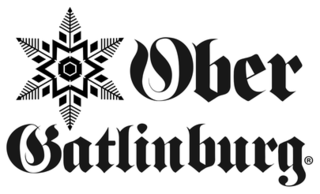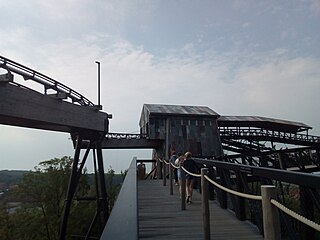
A roller coaster is a type of amusement ride employing a form of elevated railroad track that carries passengers on a train through tight turns, steep slopes, and other elements designed to produce a thrilling experience. Trains consist of open cars connected in a single line, and the rides are often found in theme parks around the world. Roller coasters first appeared in the 17th century, and LaMarcus Adna Thompson obtained one of the first known patents for a roller coaster design in 1885, based on the Switchback Railway which opened a year earlier at Coney Island.

A water slide is a type of slide designed for warm-weather or indoor recreational use at water parks. Water slides differ in their riding method and therefore size. Some slides require riders to sit directly on the slide, or on a raft or tube designed to be used with the slide.

An elevated passenger ropeway, or chairlift, is a type of aerial lift, which consists of a continuously circulating steel wire rope loop strung between two end terminals and usually over intermediate towers, carrying a series of chairs. They are the primary onhill transport at most ski areas, but are also found at amusement parks and various tourist attractions.

Sledding, sledging or sleighing is a winter sport typically carried out in a prone or seated position on a vehicle generically known as a sled, a sledge (British), or a sleigh. It is the basis of three Olympic sports: luge, skeleton and bobsledding. When practised on sand, it is known as a form of sandboarding. In Russia sledges are used for maritime activities including fishing and commuting from island to island on ice.

Snowbird is an unincorporated community in Little Cottonwood Canyon in the Wasatch Range of the Rocky Mountains near Salt Lake City, Utah, United States. It is most famous for Snowbird Ski and Summer Resort, an alpine skiing and snowboarding area, which opened in December 1971.

Disney's Blizzard Beach is a water theme park located at the Walt Disney World Resort in Bay Lake, Florida near Orlando. All water areas are heated, with the exception of the melting snow in the ice cave of Cross Country Creek.

Matterhorn Bobsleds are a pair of intertwined steel roller coasters at Disneyland in Anaheim, California. It is modeled after the Matterhorn, a mountain in the Alps on the border between Switzerland and Italy. It is the first known tubular steel track roller coaster. Located on the border between Tomorrowland and Fantasyland, it employs forced perspective to seem larger.

Blue Mountain is an alpine ski resort in Ontario, Canada, 10 km west of Collingwood. It is situated on a section of the Niagara Escarpment about 1 km (0.6 mi.) from Nottawasaga Bay, and is a major destination for skiers from southern Ontario. The local area forms the newly incorporated town of The Blue Mountains, Ontario. On average, Blue Mountain sells more than 750,000 lift tickets per year, making it the third-busiest ski resort in Canada, after Whistler-Blackcomb in British Columbia and Mont Tremblant in Quebec. It is one of the largest resorts in Ontario and has been extensively built out, featuring 42 runs, 16 chairlifts and 3 freestyle terrains.
Action Park was an amusement and water park located in Vernon Township, New Jersey, United States, on the grounds of the Vernon Valley/Great Gorge ski resort. The park consisted primarily of water-based attractions and originally opened to the public in 1978, under the ownership of Great American Recreation (GAR).

Twisted Colossus is a steel roller coaster located at Six Flags Magic Mountain in Valencia, California. Originally designed and built by International Amusement Devices, the roller coaster opened as Colossus, a dual-tracked roller coaster, on June 29, 1978. It was the tallest and fastest wooden roller coaster in the world and the first with two drops greater than 100 feet (30 m). Colossus became well known after appearances in film and television, including the box-office hit National Lampoon's Vacation and the made-for-TV movie Kiss Meets the Phantom of the Park. For 19 years, it was the park's main attraction until the opening of Superman: The Escape.

Seabreeze Amusement Park (Seabreeze) is a historic family amusement park located in Irondequoit, New York, a suburb of Rochester, where Irondequoit Bay meets Lake Ontario. According to the National Amusement Park Historical Association (NAPHA), Seabreeze is the fourth-oldest operating amusement park in the United States and the thirteenth-oldest operating amusement park in the world, having opened in 1879. The park features roller coasters, a variety of other rides, a midway, and a water park.

Steel Vengeance, formerly known as Mean Streak, is a steel roller coaster at Cedar Point in Sandusky, Ohio. The roller coaster, originally constructed by Dinn Corporation as a wooden roller coaster, was rebuilt by Rocky Mountain Construction (RMC) and opened to the public on May 5, 2018. It is a hybrid coaster, using RMC's steel I-Box track and a significant portion of Mean Streak's former support structure. Upon completion, Steel Vengeance set 10 world records, including those for the tallest, fastest, and longest hybrid roller coaster.

New Texas Giant is a steel roller coaster located at Six Flags Over Texas in Arlington, Texas. It originally opened as Texas Giant, which was the tallest wooden coaster in the world when it debuted in 1990. Manufactured by Dinn Corporation and designed by Curtis D. Summers, Texas Giant operated for nearly two decades and was highly-ranked in Amusement Today magazine's annual Golden Ticket Awards. The ride's popularity declined over the years as it gained a negative reputation for increasing roughness.

Ober Mountain Adventure Park & Ski Area, formerly known as Ober Gatlinburg, is a ski area and amusement park located in Gatlinburg, Tennessee, USA that was established in 1962. The area also contains a large mall with indoor amusements, an indoor ice skating rink, snack bars, a restaurant, and stores. An aerial tram connects Ober Mountain to downtown Gatlinburg, which is about 3 miles east.

Toboggan is a portable roller coaster that was built by Chance Industries from 1969 to the mid-1970s. The coaster features a small vehicle, holding two people, that climbs vertically inside a hollow steel tower then spirals back down around the same tower. There is a small section of track at the base of the tower with a few small dips and two turns to bring the ride vehicle back to the station. Each vehicle has a single rubber tire with a hydraulic clutch braking system that governs the speed of the vehicle as it descends the tower. The rubber tire engages a center rail that begins halfway through the first spiral. The ride stands 45 feet tall with a track length of 450 feet. A typical ride lasts approximately 70 seconds.

A rescue toboggan, also known as a rescue sled or emergency rescue sledge, or by the Finnish word ahkio, is a carrier for transporting a person or goods on snowy or icy surfaces. It is used by mountain rescue or ski patrol teams to evacuate an injured skier or snowboarder. There are related designs for use on water to carry accident victims or emergency equipment.

Dawson Duel is a racing alpine coaster at Bellewaerde near Ypres, Belgium. The attraction became the first in Europe to race two alpine coaster tracks against one another, and the first to also be built on an artificial, man-made slope instead of natural terrain. Dawson Duel's name and theme pays homage to the town of Dawson City in the Yukon Territory, and the Yukon Quest Sled dog racing event. The ride was constructed at a cost of €4,000,000 and is one of the most popular attractions in the park.

Sandia Peak Ski Area, originally La Madera Ski Area, is a ski resort located in the Sandia Mountains in northeast Bernalillo County, New Mexico, United States, immediately northeast of the city of Albuquerque. It is part of a Special Use Permit Zone in the Sandia Ranger District of the Cibola National Forest. It is New Mexico's first ski area, opening to skiers in 1936. It features Sandia Peak Tramway, which was until 2010 the longest tramway in the world, and remains the longest in the Americas. The resort includes 35 ski runs and a terrain park, and also serves as a site for summer recreation. It is one of the few ski resorts in the US that can be directly accessed from a major city.





















